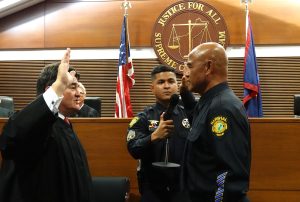MITT findings vulnerable to lawsuit
The U.S. Navy’s findings for the Marianas Islands training and testing area are vulnerable to a legal challenge, on the same grounds a court ruled against the adoption of similar military plans in the Hawaii and Southern California range, Saipan Tribune learned.
These plans failed to, among others, address a true “no action” training alternative, failed to analyze alternatives with less environmental harm, and thus failed to comply with the National Environmental Policy Act.
In March, a Hawaii court found illegal the National Marine Fisheries Service’s approval of Navy sonar, deep-sea detonation, and other training in the Hawaii/Southern California range.
These findings were found to be “arbitrary and capricious” in a 66-page court ruling that sided with the Conservation Council for Hawaii and the National Resources Defense Council, the groups suing the Service.
“Searching the administrative record’s reams of pages for some explanation as to why the Navy’s activities were authorized by the [NMFS], this court feels like the sailor in Samuel Taylor Coleridge’s The Rime of the Ancient Mariner who, trapped for days on a ship becalmed in the middle of the ocean, laments, ‘Water, water every where, nor any drop to drink,’” wrote U.S. District court Judge Susan Oki Mollway.
In the Marianas, the court ruling sets precedent for challenges to the impending go-ahead for similar training in the Marianas, and the potential authorization of incidental take or harassment by the NMFS, Saipan Tribune learned.
The Navy contends, though, that the “current ruling does not affect Navy training and testing activities outside of the Hawaii and Southern California study area” in a statement from Joint Region Marianas.
But CNMI officials have said the ruling helps set the “legal foundation” for the protection of marine mammals in the region.
Marc Fink, senior attorney for and part of the Center of Biological Diversity’s Strategic Litigation Group, one of the groups leading the Hawaii case, agreed that the MITT is similar to the EIS at issue in Hawaii “by failing to consider a true “no action” alternative.”
“…And by failing to consider a broad enough range of alternatives,” he said.
Similarly, the CNMI Joint Military Training DEIS for live-fire training on Pagan and Tinian also “fails to consider alternatives in other regions.”
Fink was responding to questions on their future involvement in the Marianas and the kind of legal foundation the Hawaii case sets for people who wish to challenge the Navy’s findings.
Fink went on to say the Center also believes the Navy has violated law by failing to consider the combined environmental impacts of these two MITT and CJMT proposals within the same EIS.
“Similar proposals in the same region at the same time must be considered together, in a single EIS,” the attorney emphasized, noting also their concern about the environmental impacts of these proposals on marine mammals and endangered species, including coral, sea turtles, and the Tinian monarch on Tinian Island.
“For both proposals, we are waiting on anticipated biological opinions by the National Marine Fisheries Service and U.S. Fish and Wildlife Service, as well as any ‘Letters of Authorization’ by the National Marine Fisheries Service concerning impacts to marine mammals. We will be carefully reviewing these documents when they are released to the public.”
“We are hopeful the Navy will realize that the environmental impacts of these proposed activities are too severe and should not move forward as currently proposed,” the attorney said.
Precedent
Fink’s comments on the MITT yesterday appear to echo arguments made in the Hawaii case, where environmental groups contend that NMFS has authorized takes through the Navy’s perspective, not theirs.
NMFS is “cooperating agency”—like the Federal Aviation Administration—in approving of military plans.
In their 2013 comments, the Center said the Navy failed to analyze a proper no action alternative in consideration of expiring permits by USFW and NSFW.
“Thus, a true no action alternative would take into account the impending expiration of these permits and authorizations” which would result in scaled back training and testing, the Center wrote, calling an assumption otherwise “arbitrary and capricious and violates NEPA.”
To this, the Navy wrote in responses released this month that “no action” means “no change” from current activity. They were citing interpretation from the Council of Environmental Quality.
“Therefore, the ‘no action’ alternative is continuing with the present course of action until the action is changed…” the Navy said.
But in ruling on the same “no action” argument in the Hawaii case, Mollway found that NMFS could not assume the same take activities the Navy was proposing.
“NMFS was neglecting to consider what would be a true ‘no action’ alternative from NMFS’s perspective,” she wrote.
“The Navy and NMFS appear to have recognized that a ‘no action’ alternative from NMFS’s perspective might well have been the scenario in which…NMFS denied the Navy’s request for an incidental take authorization,” Mollway writes.
Consider mitigation
The Center also argues that the Navy failed to consider alternatives that significantly reduce the predicted harm on marine environment in the Marianas.
Based on modeling estimates of impulsive and non-impulsive source effects for all training and testing activities, the Navy requests to be allowed to inadvertently harass over 81,000 whales and dolphins a year.
They also request to accidentally injure 15 Pygmy sperm whales and 41 dwarf sperm whales a year.
The Center argues that alternatives must include “appropriate mitigation measures” and because of this, the Navy must include or at least consider geographic restrictions from sensitive areas. These restrictions were not made in their draft EIS.
“By failing to include any consideration of alternatives that impose such restrictions…the Navy is failing to rigorously explore all reasonable alternatives,” the Center wrote.
Gov. Eloy S. Inos himself proposed mitigation zones in his 2013 letter to the Navy.
The governor requested more baseline studies, better baseline study information, and marine mammal protection areas, and that certain training activities not be done around certain islands.
Inos’ mitigation zones excluded sonar and explosives training and testing within certain distances from CNMI islands and West Mariana ridge.
But in their response this month, the Navy says they “cannot impose geographic limitations on training and testing activities based on bathymetric features.”
The Navy called this an “impractical burden with regard to implementation” and “unacceptable impact to the effectiveness” of their training.
Mollway, though, dismissed similar reasons of impracticality, in the Hawaii case.
The kind of responses to “specific proposals in public comments was general and cursory, and assumed with little analysis that no restriction at all could be accommodated,” she wrote.
Lawsuit
A letter of authorization for incidental take is pending with NMFS.
The authorization was given for the Hawaii and Southern California testing several months after the release of final impact studies.
The final studies for Marianas study area will be published in the Federal Register tomorrow.
It’s unclear right now if NMFS will adopt the Marianas findings with the Hawaii issue still in court. Request for comment from their regional office in Hawaii were not responded to as of press time.
It was gathered, though, that if NMFS does adopt the Navy’s no action alternative, they are open to a lawsuit, and the same kind of lawsuit they lost in Hawaii.







Similarly, the CNMI Joint Military Training DEIS for live-fire training on Pagan and Tinian also “fails to consider alternatives in other regions.”
Fink was responding to questions on their future involvement in the Marianas and the kind of legal foundation the Hawaii case sets for people who wish to challenge the Navy’s findings.
Fink went on to say the Center also believes the Navy has violated law by failing to consider the combined environmental impacts of these two MITT and CJMT proposals within the same EIS.
Thank you! This is a major breaking story and the kind of solid legal reporting we need on this military buildup issue.
It is important to note that although the older ocean-based Mariana Islands Training and Testing (MITT) and the more recent Pagan- and Tinian-based CNMI Joint Military Training (CJMT) proposals are separate, their effects are cumulative, as senior attorney Marc Fink of the Center of Biological Diversity’s Strategic Litigation Group insightfully points out. So is the PACAF Divert Marianas DEIS.
http://mitt-eis.com
http://www.cnmijointmilitarytrainingeis.com
http://www.pacafdivertmarianaseis.com
Mr. Fink has identified several key legal issues that have the potential, at a minimum, to postpone their implementation for years. In their haste to push things through, DoD may come to regret their stingy extension of the CJMT DEIS comment period for only an additional 60 days — leaving litigation of these issues as the last remaining choice.
I have repeatedly asked in blog comments why DoD failed to consider the Japanese cemetery and military installation on Iwo Jima as a CJMT alternative, as it has no actual or potential civilian population or planned economic development. The Philippines is another option DoD failed to examine. Now that the expansionist threat is no longer remote or theoretical, we are far from the days when DoD left Clark Field and Subic Bay in 1991 and 1992, respectively, at the host nation’s behest. These omissions are glaring in that the CJMT website designates the process as an “Overseas” Environmental Impact Statement (OEIS), at least in part.
Likewise, the failure to consider the combined impact of the MITT & CJMT proposals, and the Divert Airfield & CJMT proposals, is a ground-breaking legal issue that has never previously been reported in the CNMI press.
Nor was the cumulative effect of these proposals on the CNMI tourism economy adequately explored.
Make no mistake — this is a blockbuster legal issue that should give hope to every CNMI citizen seeking DoD to honor the commitments made in the Covenant and not despoil the limited land available to the Commonwealth!
We need to do our own part, such as amending the N.M.I. Constitution to provide for Covenant Mutual Consent (as I have again re-emphasized following an editorial today in the other paper). This will further enhance the CNMI negotiating position on any issue of disagreement between the federal and local governments.
Similarly, the CMJT DEIS 4.3.2.2 provisions to conduct Range Environmental Vulnerability Assessment for munitions constituents including high explosives (e.g., trinitrotoluene, royal demolition explosive, high melting explosive from munitions items containing high explosives), perchlorate (from propellant in rocket fuels), and lead (from small arms) do not consider the cumulative exposure on Tinian residents who must endure these ground water toxins for their whole lives, including the biological developmentally sensitive periods of pregnancy, infancy, childhood, and adolescence.
CJMT DEIS/ODEIS 4.3.2.2, Best Management Practices and Standard Operating Procedures, http://cnmimarines.s3.amazonaws.com/static/DraftEIS/Chapter%203-4%20%28Resources%29/Ch.%204/4.3%20-%20Water%20Resources.pdf#page=4 .